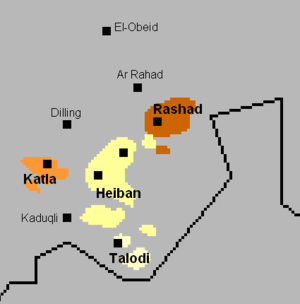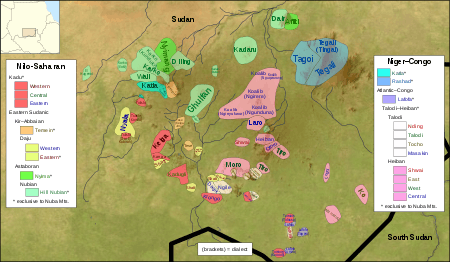Kordofanian languages
The Kordofanian languages are a geographic grouping of five language groups spoken in the Nuba Mountains of the Kurdufan, Sudan: Talodi–Heiban languages, Lafofa languages, Rashad languages, Katla languages and Kadu languages. The first four groups are branches of the Niger–Congo family, whereas Kadu is now widely seen as a branch of the Nilo-Saharan family.
| Kordofanian | |
|---|---|
| (geographic) | |
| Geographic distribution | Kurdufan |
| Linguistic classification | Niger–Congo
|
| Subdivisions |
|
| ISO 639-5 | kdo |
| Glottolog | None |
 | |
History
In 1963, Joseph Greenberg added them to the Niger–Congo family, creating his Niger–Kordofanian proposal. The Kordofanian languages have not been shown to be more distantly related than other branches of Niger–Congo, however, and they have not been shown to constitute a valid group. Today, the Kadu languages are excluded, and the others are usually included in Niger–Congo proper.
Roger Blench notes that the Talodi and Heiban families have the noun class systems characteristic of the Atlantic–Congo core of Niger–Congo but that the two Katla languages have no trace of ever having had such a system. However, the Kadu languages and some of the Rashad languages appear to have acquired noun classes as part of a Sprachbund rather than having inherited them. Blench concludes that Talodi and Heiban are core Niger–Congo whereas Katla and Rashad form a peripheral branch along the lines of Mande.

Talodi–Heiban languages
The Heiban languages, also called Koalib or Koalib–Moro, and the Talodi languages, also called Talodi–Masakin, are part of the Talodi–Heiban group.[1]
Lafofa languages
Lafofa (Tegem) was for a time classified with Talodi, but appears to be a separate branch of Niger–Congo.
Rashad languages
The number of Rashad languages, also called Tegali–Tagoi, varies among descriptions, from two (Williamson & Blench 2000), three (Ethnologue), to eight (Blench ms). Tagoi has a noun-class system like the Atlantic–Congo languages, which is apparently borrowed, but Tegali does not.
Katla languages
The two Katla languages have no trace of ever having had a Niger–Congo-type noun-class system.
Kadu languages
Since the work of Thilo Schadeberg in 1981, the "Tumtum" or Kadu branch is now widely seen as Nilo-Saharan. However, the evidence is slight, and a conservative classification would treat it as an independent family.
Comparative vocabulary
Sample basic vocabulary of the Heiban, Talodi, Rashad, and Lafofa branches:
Note: In table cells with slashes, the singular form is given before the slash, while the plural form follows the slash.
| Language | eye | ear | nose | tooth | tongue | mouth | blood | bone | tree | water | eat | name |
|---|---|---|---|---|---|---|---|---|---|---|---|---|
| Proto-Heiban[2] | *ay / g-,j- | *-aani | *-ad̪alo / g-,j-; g-,n- | *-ŋad̪ / li-,j- | *-ŋela; *-iŋla ? / D-,d- | *-uuɲu | *-win / ŋ- | *-uya / li-,ŋu- (WC); *-uɲ / ʔ-,j- (E) | *-aaɽe / gu-,j- (WC) | *-aw / ŋ- | *-id̪d̪- | *-iriɲ / j- |
| Proto-Talodi[3] | *c-it / k- | *k-ɛnu / 0- | *k-ə-ɲɟɛ / 0-,n- | *c-ə-ɲit / k- | *tʊ̪ -ləŋɛ / ḷə- | *t-̪ ɔn̪ / ḷ- | *ŋ-ɪccʊk | *c-ə-mma-ɲan̪ / m- | *p-ɪda / k- | *ŋ-ɪḷ,-ɪḷɪ | *ḷə-ɡɔ | *k-ə-ḷəŋan / 0- (or *...n̪) |
| Proto-Katloid[4] | *g-ɪgɛd̪ | *-ɔnɔ | *gɪ-lɛd̪ | *-laŋɛd̪ | *i-ju(u) | *-ʌ-lV- | ||||||
| Tagoi[5] | yígət / ŋə́gət | fənín / fənédit | yídir / ŋə́dər | tíɲən / ŋə́ɲən | táŋə́lak / yáŋə́lágɒt | kajər / hájɛrət | ŋɔ́y | kuh / huh | kafɔ́ / hafɔ́ | ŋay | yɛk | pəŋən / fəŋən |
| Turjok[5] | íŋgət / ŋ̀gət | fəniín / fəníínət | indər / ŋəndər | M. tiɲin / ŋiɲin | taŋəlk / yaŋəlak ~ yaŋəlɒgɔt | kiɲjɛr / siɲjɛr(g)ɔt | ŋɔ́y | kus / sus | kafɔ / safɔ́ | ŋaay | pɛŋɛn / sɛŋɛn | |
| Tagom[5] | ŋgə́t̚ / ŋgə́de | nu ~ nũũ / núun ~ anuun | ndr̀ / ndr̀re | ɲîn / ɲîne | aŋa / aŋún | ̩ɲjár / (a)ɲjáre | óyá / óyo̍n | uru / urûn | lás / lásɛ | ega | yɛk | ɛŋɛn / ɛŋɛnɛ́ɛn |
| Tegem[6] | ṭ-ì, ʤ-ì / m- | kә́-ràŋ(ì) / a- | ṭ-ɛ̀ɲ(ì) / k- | l-iәŋ(ì) | k-ɛɲi / ɛɲi | ɲɪ̀ | ṭ-uɔ̀m(ì) / m- | kuwö(ì) / bɔɔ(ì) | ɲìì | kɪ́rɪ̀k | ku-ruwә̀ŋ / a- | |
| El Amira[6] | lilaŋ / ɲimaŋ | wimu | t-aɲ / k- | liŋ | kiɲ | ɲi | tuwam | kwa | ɲi | palith |
Numerals
Comparison of numerals in individual languages:[7]
| Classification | Language | 1 | 2 | 3 | 4 | 5 | 6 | 7 | 8 | 9 | 10 |
|---|---|---|---|---|---|---|---|---|---|---|---|
| Katla | Katla | ʈíʈʌ́k | cík | ʌ̀t̪ʌ́t̪ | ʌ̀ɡʌ́lʌ̀m | ɟɔ́ɡ͡bə́lɪ́n | ɟɔ́lʈɪ́n | ɟɔ́lɪ́k | t̪ʌ́ŋɡɪ̀l | ɟʌ́lbʌ̀ʈɪ́n | ràk͡pác |
| Katla | Tima | ʌt̪een / at̪ɪɪn | iheek | ihwʌy | ihʌlʌm | iduliin | ɪntədakwalɔŋ | ɪnt̪at̪ɪŋɛɛl | ɪnt̪ɪŋɛrɛy | int̪ʌhʌdʌkun | ihedʌkún |
| Rashad | Tagoi (Orig) | -wàttá / ùttá | wùkkók | wìttá | wàrʊ̀m | wʊ̧ràm | ɲérér | ʊ̀mʊ̀rɡʊ́ | tùppá | kʊ́mnàsá(n) | kʊ́mán |
| Rashad | Tegali | m̪t̪a | rəkkʊ / rʊkkʊ | d̪akt̪a / d̪at̪t̪a | aːrəm | ʊmmə | ɲeˑɽe | ʊmmərkʊ | duˑpˑa | fəŋɪsan | fəŋən |
| Heiban | Warnang (Werni/Wernang) | ŋɔ̀ʈʈɔ́r | ŋèrccáccény | ŋèrráttén | ŋèlàmlàŋ | ŋera ŋoʈʈor | ŋera ŋoʈʈor ŋemabolo ŋoʈʈor (5+1?) | ŋera ŋoʈʈor ŋemabolo ŋèrccáccény (5+2?) | ŋelamlaaŋɔ (4 x 2 ?) | ŋera ŋoʈʈor wanoe (1- ?) | kiccukurrɐ |
| Heiban | Moro | ɡónto | lə́ɡə́tʃan | lə́ɡɪ́tʃɪn | márlon | ðénə́ŋ | ðénə́ŋ nəɡónto (5+ 1) | ðénə́ŋ lə́ɡə́tʃan (5+ 2) | ðénə́ŋ lə́ɡɪ́tʃan (5+ 3) | ðénə́ŋ nəmárlon (5+ 4) | rɛ́θ |
| Heiban | Tira | kɛ̀nːɛ | kɪ̀ɽɪcàn | kɪ̀ɽɪcɪ́n | maɬɽʊ̀ | ðɛ́nɛ̀ | ɽɪ̀cín ɽɪ̀cɪ̀n (3+3) | maɬɽʊ kɪ̀ɽɪcɪ̀n (4+3) | ɔ́bːɔ̀ | ðɛ́nɛ̀ n̪maɬɽʊ̀ (5+4) | ʊ́rːɪ̀ |
| Heiban | Laro | kʷɛ̀tɛ̀ | rɔ́m | tə̀ɽìl | kʷɔ̀ɾɔ̀ŋɔ́ | tʊ̀dìní | ɲə̀rlə̀l | kʷɔ̀ɾátə̀ɾìl (4+3) | ɗúbə̀ | tʊ̀dìní kʷɔ̀ɾɔ̀ŋɔ́ (5+ 4) | dí |
| Heiban | Otoro | wɛ̀dɔ́ŋ | kútèn | t̪èɽel | kɔ̀ɽɔŋ | t̪ɔ̀ðːnɛ | ɲɛ̄ɽɛl | kɔ̀ɽɔ t̪eɽel (4+3) | dúbə | t̪ɔ́ðːnɛ́ kɔ̀ɽɔŋ (5+ 4) | dìː |
| Heiban | Koalib (1) | kwɛ́t:ɛ | kwiɽín | tɛjɪɾ | kɔɽŋɔn | tuðní | ɲiɾlíl | kunəðɗuβə | ɗuβaβuŋa | kunəðɗi | ɗí |
| Heiban | Koalib (2) | -ɛ̀t̪t̪ɛ̀ | -iɽɐn | tɔɔɽɔl | twaɽŋan | toðne | ɲerlel | ɗòvɔ̀kkwóɽɔ̀n | ɗòvɔ̀kkwóppà | kwúnɐ̀ttùrrí | rúi |
| Talodi | Dagik | j-ɜlːʊ | j-ɛːɽa | j-ɜt̪ːɜk̚ | bɽandɔ | si-s-ɜlːʊ (litː one hand) | na-j-ɜlːʊ (5 + 1) | na j-ɛːɽa (5 + 2) | na j-ɜt̪ːɜk̚ (5 + 3) | na bɽandɔ (5 + 4) | n̪ipɽa |
| Talodi | Acheron | bulluk | weɽʌk | wʌt̪t̪ʌk | bɽando | zəɡuŋ zulluk (lit: 'one hand') | zəɡuŋ zulluk na bulluk (5 + 1) | zəɡuŋ zulluk na weɽʌk (5 + 2) | zəɡuŋ zulluk na wʌt̪t̪ʌk (5 + 3) | zəɡuŋ zulluk na bɽando (5 + 4) | ɡurruŋ |
| Talodi | Lumun | cʊ́lʊ́kʊ̂ | mɛ̀ɽá | mɽaβʊ́ɾʊ̀k | mɔ́ʲɔ̀ɽɪ̀n | mʊ́ɣʊ́lʊ̀k | mɽakʊ́ɾʊ̀k | mɛ́ɽɛ̀ɽàβʊ́ɾʊ̂k ( 3) ? | mámɔ̀ɾmɔ̀ɾ (2 x 4) ? | mʊ́ɣʊ́lláʲɔ̀ɽɪ̀n (5 + 4) | mɑ̀tul |
See also
References
- Gerrit Dimmendaal, 2008. "Language Ecology and Linguistic Diversity on the African Continent", Language and Linguistics Compass 2/5:842.
- Schadeberg, Thilo C. 1981. A Survey of Kordofanian. Volume 1: The Heiban Group. Hamburg: Helmut Buske.
- Norton, Russell, and Thomas Kuku Alaki. 2015. The Talodi Languages: A Comparative-Historical Analysis. Occasional papers in the study of Sudanese languages 11:31-161.
- Dimmendaal, Gerrit J. 2019 (in press). Reconstructing Katloid and deconstructing Kordofanian. In: Schneider-Blum et al. (eds.): Nuba Mountain Languages Studies 3. Cologne: Rüdiger Köppe.
- Schadeberg, Thilo. 2013. Rashad survey data. In Roger Blench & Thilo Schadeberg (eds), Nuba Mountain Language Studies. Cologne: Rüdiger Köppe. pp.325-345.
- Blench, Roger. 2016. Tegem-Amira: a previously unrecognised subgroup of Niger-Congo.
- Chan, Eugene (2019). "The Niger-Congo Language Phylum". Numeral Systems of the World's Languages.
Bibliography
- Herman Bell. 1995. The Nuba Mountains: Who Spoke What in 1976? (archive link). Being a study of the published results from a major project of the Institute of African and Asian Studies: the Language Survey of the Nuba Mountains.
- Roger Blench. Unpublished. Does Kordofanian constitute a group and if not, where does its languages fit into Niger-Congo?
- Roger Blench. Unpublished. Kordofanian and Niger–Congo: new and revised lexical evidence.
- Roger Blench, 2011, Should Kordofanian be split up?, Nuba Hills Conference, Leiden
- P. A. and D. N. MacDiarmid. 1931. "The languages of the Nuba Mountains." Sudan Notes and Records 14: 149-162.
- Carl Meinhof. 1915-1919. "Sprachstudien im egyptischen Sudan". Zeitschrift für Kolonialsprachen 9-9. "1. Tagoy." 6: 164-161. "2. Tumale". 6:182-205. "11. Tegele." 7:110-131. "12. Rashad." 7:132.
- Thilo C. Schadeberg. 1981a. A survey of Kordofanian. SUGIA Beiheft 1-2. Hamburg:Helmut Buske Verlag.
- Thilo C. Schadeberg. 1981b. "Das Kordofanische". Die Sprachen Afrikas. Band 1: Niger–Kordofanisch, ed. by Bernd Heine, T. C. Schadeberg, Ekkehard Wolff, pp. 117–28 SUGIA Beiheft 1-2. Hamburg:Helmut Buske Verlag.
- Thilo C. Schadeberg. 1981c. "The classification of the Kadugli language group". Nilo-Saharan, ed. by T. C. Schadeberg and M. Lionel Bender, pp. 291–305. Dordrecht: Foris Publications.
- Brenda Z. Seligmann. 1910-11. "Note on the language of the Nubas of Southern Kordofan." Zeitschrift für Kolonialsprachen 1:167-188.
- Roland C. Stevenson. 1956-57. "A survey of the phonetics and grammatical structure of the Nuba Mountains languages, with particular reference to Otoro, Katcha, and Nyimang." Afrika und Übersee 40:73-84, 93-115; 41:27-65, 117-152, 171-196.
- Tucker, A. N. and M. A. Bryan. 1956. The Non-Bantu Languages of North-Eastern Africa. (Handbook of African Languages, Part III.) Oxford University Press: London.
- A. N. Tucker and M. A. Bryan. 1966. Linguistic Analyses/The Non-Bantu Languages of North-Eastern Africa. (Handbook of African Languages.) Oxford University Press: London.
- Tutschek, Lorenz. 1848. "Über die Tumale-Sprache." Gelehrte Anzeigen, herausgegeben von Mitgliedern der k. bayer. Akademie der Wissenschaften. Nrs. 91-93; Spalten 729-52. (=Bulletin der königl. Akademie der Wissenschaften. Nrs. 29-31.)
- Tutschek, Lorenz.. 1848-50. "On the Tumali language". Proceedings of the Philological Society for 1846-47 and 1847-48. Vol 3:239-54. Proceedings of the Philological Society for 1848-49 and 1849-50. Vol. 4:138-9.
External links
![]()